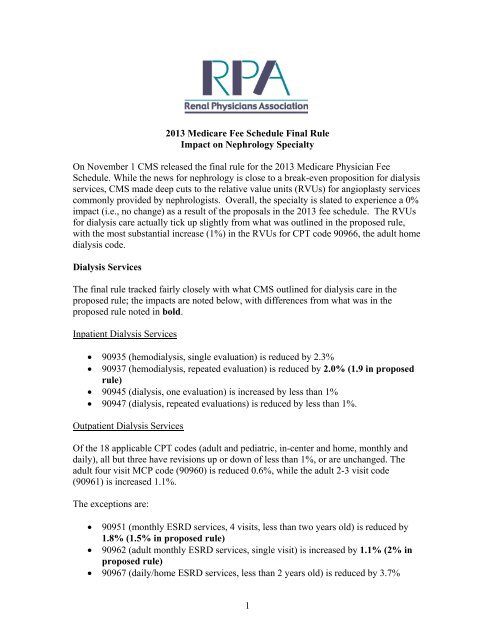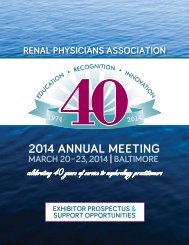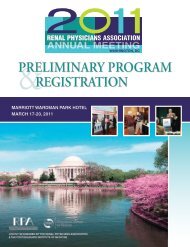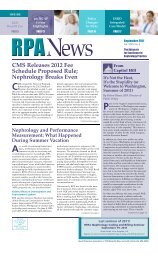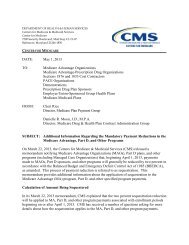2013 Medicare Fee Schedule Final Rule Impact on Nephrology ...
2013 Medicare Fee Schedule Final Rule Impact on Nephrology ...
2013 Medicare Fee Schedule Final Rule Impact on Nephrology ...
You also want an ePaper? Increase the reach of your titles
YUMPU automatically turns print PDFs into web optimized ePapers that Google loves.
<str<strong>on</strong>g>2013</str<strong>on</strong>g> <str<strong>on</strong>g>Medicare</str<strong>on</strong>g> <str<strong>on</strong>g>Fee</str<strong>on</strong>g> <str<strong>on</strong>g>Schedule</str<strong>on</strong>g> <str<strong>on</strong>g>Final</str<strong>on</strong>g> <str<strong>on</strong>g>Rule</str<strong>on</strong>g><br />
<str<strong>on</strong>g>Impact</str<strong>on</strong>g> <strong>on</strong> <strong>Nephrology</strong> Specialty<br />
On November 1 CMS released the final rule for the <str<strong>on</strong>g>2013</str<strong>on</strong>g> <str<strong>on</strong>g>Medicare</str<strong>on</strong>g> Physician <str<strong>on</strong>g>Fee</str<strong>on</strong>g><br />
<str<strong>on</strong>g>Schedule</str<strong>on</strong>g>. While the news for nephrology is close to a break-even propositi<strong>on</strong> for dialysis<br />
services, CMS made deep cuts to the relative value units (RVUs) for angioplasty services<br />
comm<strong>on</strong>ly provided by nephrologists. Overall, the specialty is slated to experience a 0%<br />
impact (i.e., no change) as a result of the proposals in the <str<strong>on</strong>g>2013</str<strong>on</strong>g> fee schedule. The RVUs<br />
for dialysis care actually tick up slightly from what was outlined in the proposed rule,<br />
with the most substantial increase (1%) in the RVUs for CPT code 90966, the adult home<br />
dialysis code.<br />
Dialysis Services<br />
The final rule tracked fairly closely with what CMS outlined for dialysis care in the<br />
proposed rule; the impacts are noted below, with differences from what was in the<br />
proposed rule noted in bold.<br />
Inpatient Dialysis Services<br />
• 90935 (hemodialysis, single evaluati<strong>on</strong>) is reduced by 2.3%<br />
• 90937 (hemodialysis, repeated evaluati<strong>on</strong>) is reduced by 2.0% (1.9 in proposed<br />
rule)<br />
• 90945 (dialysis, <strong>on</strong>e evaluati<strong>on</strong>) is increased by less than 1%<br />
• 90947 (dialysis, repeated evaluati<strong>on</strong>s) is reduced by less than 1%.<br />
Outpatient Dialysis Services<br />
Of the 18 applicable CPT codes (adult and pediatric, in-center and home, m<strong>on</strong>thly and<br />
daily), all but three have revisi<strong>on</strong>s up or down of less than 1%, or are unchanged. The<br />
adult four visit MCP code (90960) is reduced 0.6%, while the adult 2-3 visit code<br />
(90961) is increased 1.1%.<br />
The excepti<strong>on</strong>s are:<br />
• 90951 (m<strong>on</strong>thly ESRD services, 4 visits, less than two years old) is reduced by<br />
1.8% (1.5% in proposed rule)<br />
• 90962 (adult m<strong>on</strong>thly ESRD services, single visit) is increased by 1.1% (2% in<br />
proposed rule)<br />
• 90967 (daily/home ESRD services, less than 2 years old) is reduced by 3.7%<br />
1
Angioplasty Code Reducti<strong>on</strong>s<br />
With regard to the angioplasty codes (CPT codes 35475—arterial angioplasty, and<br />
35476—venous angioplasty), the total RVUs for these services were unilaterally reduced<br />
by CMS by approximately 28% and 15%, respectively, from the 2012 values for these<br />
codes.<br />
The reducti<strong>on</strong>s for these services came <strong>on</strong> the heels of review of the services by the<br />
AMA’s Relative Value Update Committee (RUC) in April 2012. As part of the RUC<br />
review process, RPA, the American Society of Diagnostic and Interventi<strong>on</strong>al <strong>Nephrology</strong><br />
(ASDIN), and allied groups surveyed these codes and presented a collaborative proposal<br />
for valuing the services to the RUC. While the RUC review did result in a slight<br />
reducti<strong>on</strong> of the work values for the codes from previous levels, it was relatively minimal<br />
and the practice expense values for these services (which represents the majority of the<br />
overall value for the services) was preserved. Thus, while the RVUs for the services<br />
were reduced, the vast majority of the total value of the services was preserved, and in<br />
light of the fact that CMS has traditi<strong>on</strong>ally accepted 80-90% of RUC recommendati<strong>on</strong>s,<br />
RPA and ASDIN believed that the review of the angioplasty codes had been a success<br />
overall.<br />
However, up<strong>on</strong> review of the final fee schedule rule released by CMS <strong>on</strong> November 1 it<br />
is clear that CMS did not accept the RUC recommendati<strong>on</strong>s. CMS agreed with the<br />
RUC’s approach of selecting a similar service as a starting point for RVU development,<br />
removing overlapping work inputs, and arriving at a recommended RVU for the service.<br />
Unfortunately, CMS selected for the starting points services with substantially lower<br />
work RVUs. As a result, while the RUC recommended 6.60 work RVUs for 35475,<br />
CMS assigned a work RVU of 5.75 to the service. Similarly, in c<strong>on</strong>trast to the RUC<br />
recommendati<strong>on</strong> of 5.50 for 35476, CMS assigned a work RVU of 4.71 to the service.<br />
CMS does note in the rule that these RVU levels are being assigned to the services <strong>on</strong> an<br />
interim final basis, and RPA will submit comments to the Agency that will point out the<br />
counterproductive impact these reducti<strong>on</strong>s may have <strong>on</strong> fistula creati<strong>on</strong> for kidney<br />
disease patients. However, the advocacy effort to c<strong>on</strong>vince CMS to rec<strong>on</strong>sider and<br />
upwardly revise the RVU levels for these services will be quite challenging.<br />
E-Prescribing Changes/Meaningful Use (MU) Hardship Exempti<strong>on</strong>s<br />
The final rule outlined several changes to the e-prescribing program, as noted below:<br />
• The definiti<strong>on</strong> of group practice for the eRx Incentive Program is now tied to the<br />
definiti<strong>on</strong> of group practice under PQRS. Since CMS is changing the definiti<strong>on</strong> of<br />
group practice in PQRS to allow groups of 2-24 eligible professi<strong>on</strong>als (EPs) to<br />
participate in PQRS as a group practice, accordingly, group practices of 2-24<br />
eligible professi<strong>on</strong>als will be able to participate in the eRx Incentive Program as a<br />
group practice in <str<strong>on</strong>g>2013</str<strong>on</strong>g> (that is, for the <str<strong>on</strong>g>2013</str<strong>on</strong>g> incentive and 2014 payment<br />
adjustment).<br />
2
• To be a successful electr<strong>on</strong>ic prescriber for the <str<strong>on</strong>g>2013</str<strong>on</strong>g> incentive, group practices<br />
comprised of 2-24 EPs that are participating in the eRx GPRO must report the<br />
electr<strong>on</strong>ic prescribing measure at least 75 times during the applicable 12-m<strong>on</strong>th<br />
reporting period (January 1, <str<strong>on</strong>g>2013</str<strong>on</strong>g> – December 31, <str<strong>on</strong>g>2013</str<strong>on</strong>g>) for the <str<strong>on</strong>g>2013</str<strong>on</strong>g> incentives.<br />
For 2014, group practices comprised of 2-24 EPs that are participating in the eRx<br />
GPRO must report the electr<strong>on</strong>ic prescribing measure at least 75 times during the<br />
applicable 2014 6-m<strong>on</strong>th payment adjustment reporting period.<br />
With regard to new MU hardship exempti<strong>on</strong>s:<br />
• To qualify for a significant hardship exempti<strong>on</strong> under this category for the <str<strong>on</strong>g>2013</str<strong>on</strong>g><br />
payment adjustment, an eligible professi<strong>on</strong>al (or every eligible professi<strong>on</strong>al in a<br />
group practice participating in the eRx GPRO for the <str<strong>on</strong>g>2013</str<strong>on</strong>g> payment adjustment)<br />
must have achieved meaningful use of Certified EHR Technology under the EHR<br />
Incentive Program for a c<strong>on</strong>tinuous 90-day EHR reporting period that fell within<br />
the 12-m<strong>on</strong>th (January 1, 2011 – December 31, 2011) or 6-m<strong>on</strong>th (January 1,<br />
2012 – June 30, 2012) payment adjustment reporting period or for an EHR<br />
reporting period that is the full CY 2012.<br />
• To qualify for a significant hardship exempti<strong>on</strong> under this category for the 2014<br />
payment adjustment, an eligible professi<strong>on</strong>al (or every eligible professi<strong>on</strong>al in a<br />
group practice participating in the eRx GPRO) must achieve meaningful use of<br />
Certified EHR Technology under the EHR Incentive Program for a c<strong>on</strong>tinuous<br />
90-day EHR reporting period that falls within the 12-m<strong>on</strong>th (January 1, 2012 –<br />
December 31, 2012) or 6-m<strong>on</strong>th (January 1, <str<strong>on</strong>g>2013</str<strong>on</strong>g> – June 30, <str<strong>on</strong>g>2013</str<strong>on</strong>g>) payment<br />
adjustment reporting period or for an EHR reporting period that is the full CY<br />
2012.<br />
Other Issues<br />
• SGR Reducti<strong>on</strong>—The final rule also includes a statutorily required 26.5% acrossthe-board<br />
reducti<strong>on</strong> to <str<strong>on</strong>g>Medicare</str<strong>on</strong>g> payment rates. The press release for the rule<br />
states that “for more than 1 milli<strong>on</strong> physicians and n<strong>on</strong>-physician practiti<strong>on</strong>ers<br />
under the Balanced Budget Act of 1997’s Sustainable Growth Rate (SGR)<br />
methodology. However, C<strong>on</strong>gress has overridden the required reducti<strong>on</strong> every<br />
year since 2003. The Administrati<strong>on</strong> is committed to fixing the SGR update<br />
methodology and ensuring these payment cuts do not take effect. Predictable,<br />
fiscally-resp<strong>on</strong>sible physician payments are essential for <str<strong>on</strong>g>Medicare</str<strong>on</strong>g> to sustain<br />
quality and lower health care costs over the l<strong>on</strong>g-term.”<br />
• New Discharge Care Management Codes—CMS also finalized two new postdischarge<br />
care management codes that pay providers for care coordinati<strong>on</strong> that<br />
occurs outside of a face-to-face visit. These codes are:<br />
o 99495, Transiti<strong>on</strong>al Care Management Services, moderate complexity,<br />
requiring a face-to-face visit within 14 calendar days of discharge; and<br />
3
o 99496, Transiti<strong>on</strong>al Care Management Services, high complexity,<br />
requiring a face-to-face visit within 7 calendar days of discharge<br />
Note: The new discharge management codes are not applicable to MCP patients.<br />
• Value-Based Modifier—In additi<strong>on</strong>, the final rule c<strong>on</strong>tinues the careful<br />
implementati<strong>on</strong> of the physician value-based payment modifier by phasing in<br />
applicati<strong>on</strong> of the modifier and enabling physicians in larger groups to choose<br />
how to participate. The value-based modifier provides differential <str<strong>on</strong>g>Medicare</str<strong>on</strong>g><br />
payments to physicians based <strong>on</strong> comparis<strong>on</strong> of the quality of care furnished to<br />
beneficiaries and the cost of care. The statute allows CMS to phase in the value<br />
modifier over three years from 2015 to 2017. For 2015, the final rule applies the<br />
value modifier to groups of physicians with 100 or more eligible professi<strong>on</strong>als, a<br />
change from the proposed rule, which would have set the group size at 25 or<br />
above. This change was adopted to gain experience with the methodology and<br />
approach before expanding it to smaller groups.<br />
Kidney-Related PQRS <str<strong>on</strong>g>2013</str<strong>on</strong>g> Measures<br />
CMS included the following kidney-disease related measures in the final rule, which are<br />
unchanged from those published in this summer’s proposed rule.<br />
Measure # Measure Title Descripti<strong>on</strong> Reporting Opti<strong>on</strong><br />
No NQF #/<br />
Claims<br />
No PQRS #<br />
Registry<br />
NQF 1667/<br />
No PQRS #<br />
NQF 0323/<br />
PQRS 81<br />
Pediatric End-<br />
Stage Renal<br />
Disease<br />
Measure<br />
(AMA/ASPN):<br />
Pediatric<br />
Kidney<br />
Disease:<br />
Adequacy of<br />
Volume<br />
Management<br />
Pediatric<br />
Kidney<br />
Disease:<br />
ESRD<br />
Patients<br />
Receiving<br />
Dialysis:<br />
Hemoglobin<br />
Level
NQF 0321/<br />
PQRS 82<br />
AQA<br />
adopted/<br />
PQRS121<br />
(This would<br />
seem to be<br />
NQF #1668)<br />
AQA<br />
adopted/<br />
PQRS 122<br />
AQA<br />
adopted/<br />
PQRS 123<br />
Adequacy:<br />
Solute<br />
Adult Kidney<br />
Disease:<br />
Perit<strong>on</strong>eal<br />
Dialysis<br />
Adequacy:<br />
Solute<br />
Adult Kidney:<br />
Disease<br />
Laboratory<br />
Testing<br />
(Lipid Profile)<br />
Adult Kidney<br />
Disease:<br />
Blood Pressure<br />
Management<br />
Adult Kidney<br />
Disease:<br />
Patients On<br />
Erythropoiesis -<br />
Stimulating<br />
Agent (ESA)<br />
- Hemoglobin<br />
Level > 12.0<br />
g/dL<br />
ESRD receiving hemodialysis<br />
three times a week who have a spKt/V ≥<br />
1.2<br />
Percentage of patients aged 18 years and<br />
older with a diagnosis of ESRD receiving<br />
perit<strong>on</strong>eal dialysis who have a total Kt/V ≥<br />
1.7 per week<br />
measured <strong>on</strong>ce every 4 m<strong>on</strong>ths<br />
Percentage of patients aged 18 years and<br />
older with a diagnosis of CKD (stage 3, 4,<br />
or 5, not receiving Renal<br />
Replacement Therapy<br />
[RRT]) who had a fasting<br />
lipid profile performed at<br />
least <strong>on</strong>ce within a 12-m<strong>on</strong>th period<br />
Percentage of patient visits for those<br />
patients aged 18 years and older with a<br />
diagnosis of CKD (stage 3, 4, or 5, not<br />
receiving Renal Replacement Therapy<br />
[RRT]) and documented<br />
proteinuria with a blood<br />
pressure < 130/80 mmHg<br />
OR ≥ 130/80 mmHg with<br />
a documented plan of care<br />
Percentage of calendar m<strong>on</strong>ths within a 12-<br />
m<strong>on</strong>th period during which a Hemoglobin<br />
level is measured for patients aged 18 years<br />
and older with a diagnosis of advanced<br />
Chr<strong>on</strong>ic Kidney Disease (CKD) (stage 4 or<br />
5, not receiving Renal Replacement<br />
Therapy [RRT]) or End Stage Renal<br />
Disease (ESRD)<br />
(who are <strong>on</strong> hemodialysis<br />
or perit<strong>on</strong>eal dialysis) who<br />
are also receiving ESA<br />
therapy AND have a<br />
Hemoglobin level > 12.0 g/dL<br />
Registry<br />
Claims<br />
Registry<br />
Measure Groups<br />
Claims<br />
Registry<br />
Measure Groups<br />
Claims<br />
Registry<br />
Measure Groups<br />
The final rule will be officially published in the Federal Register <strong>on</strong> November 16, and<br />
comments will be due <strong>on</strong> or around December 31. Check the RPA website at<br />
www.renalmd.org after that date to review RPA’s comments.<br />
5


